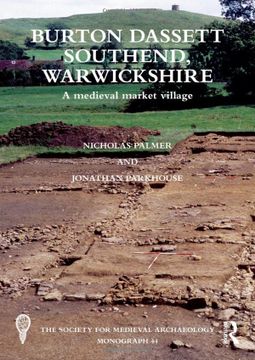Burton Dassett Southend, Warwickshire: A Medieval Market Village (The Society for Medieval Archaeology Monographs) (en Inglés)
Reseña del libro "Burton Dassett Southend, Warwickshire: A Medieval Market Village (The Society for Medieval Archaeology Monographs) (en Inglés)"
Southend, one of five medieval settlements in Burton Dassett parish, Warwickshire, was the site of a market promoted by the manorial lord Bartholomew de Sudeley, with a charter being obtained in 1267. The settlement prospered, becoming known as Chipping Dassett, and approached urban status, but then declined throughout the 15th century. It was subjected to depopulation in 1497. The site survived as earthworks in pasture until construction of the M40 motorway necessitated the archaeological programme described here. The only building to survive was the 13th-century chapel of St James, reduced, along with an adjacent post-medieval priest's house, to a cow-shed.Open area excavations at Southend investigated parts of ten medieval properties. There was some prehistoric and Romano-British activity, with evidence for woodland regeneration and subsequent clearance in the post-Roman period, despite the Feldon area being one often considered to have little in the way of tree-cover since the Roman period. The main period of occupation lasted from the mid-13th century to the late 15th century, reflecting the rise and decline of Chipping Dassett. Over 20 complete plans of houses and outbuildings were recorded, exhibiting a range of building techniques. The remains were well preserved, the surviving stratigraphy protected by demolition rubble. In most houses successive building phases were revealed and many internal features survived. A door jamb inscribed with the name of a tenant family 'Gormand' suggests a degree of functional literacy. One of the properties was recognised as a smithy during the excavation and a pioneering sampling and analysis of the ironworking evidence was carried out. The site was also sampled extensively for charred plant remains and, unusually for Warwickshire with its slightly acid soils, a large assemblage of animal bone was collected. Work on these provides direct evidence of medieval agricultural practice, to be compared with the local historical evidence. The large quantities of finds recovered, probably the largest assemblage from a medieval rural settlement in the West Midlands, enable the reconstruction of the material culture of a late medieval Warwickshire Feldon village.Although the excavated area lay away from the original settlement nucleus, the investigation revealed the mechanics of 13th-century market development with two separate stages of planned development apparent. After the mid-14th century the tenements show a complex pattern of decline leading up to the depopulation of 1497. The different properties followed varying development paths and the excavations chart a process of general community decline against a background of increasing individual prosperity. The evidence of material culture and settlement morphology, taken together, are relevant to the discussion about differentiation and similarities between urban and rural settlement. The medieval pottery has been crucial to the development of the Warwickshire type series. Identification of the pottery sources provides evidence for trade connections between the settlement and the wider market network, with the quantities of material from the Chilvers Coton kilns suggesting that manorial connections with North Warwickshire, where the Sudeley family also held land, were significant. The summary narrative and thematic discussions (focused upon material culture, spatial organisation, buildings and economy) in this volume are supplemented by detailed stratigraphic description and specialist reports available online through the Archaeology Data Service.

